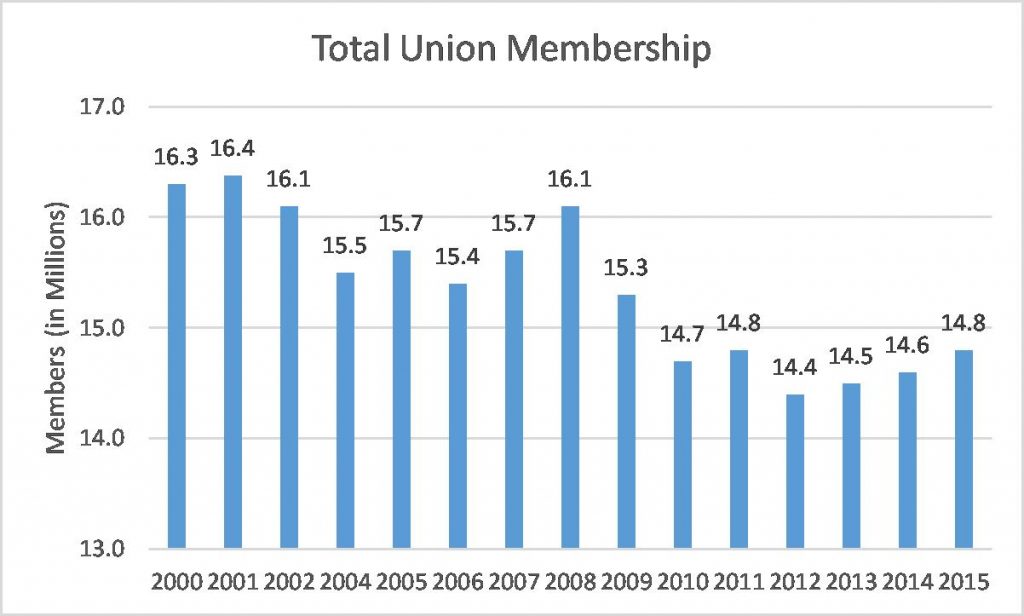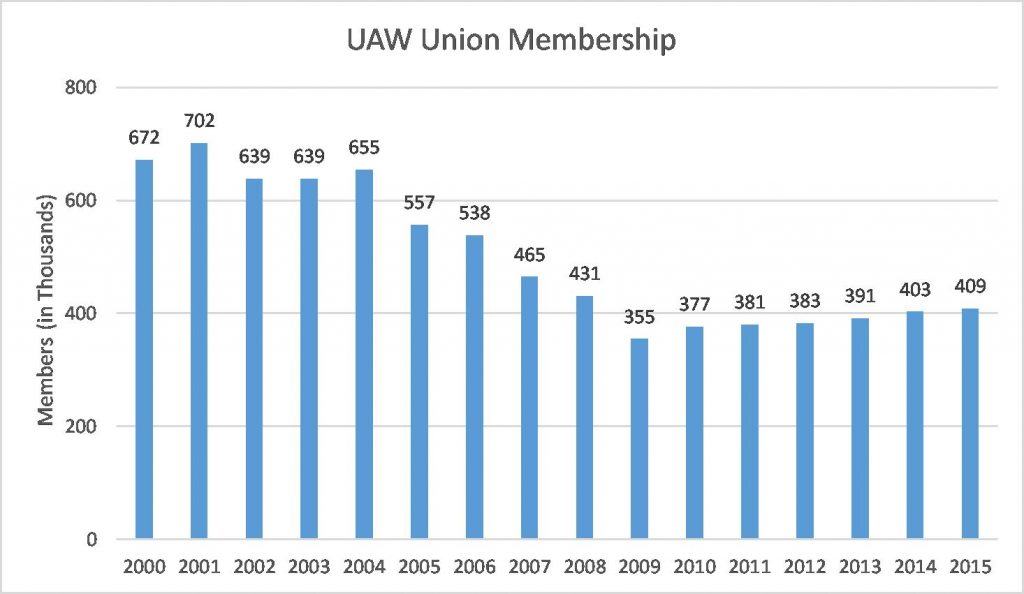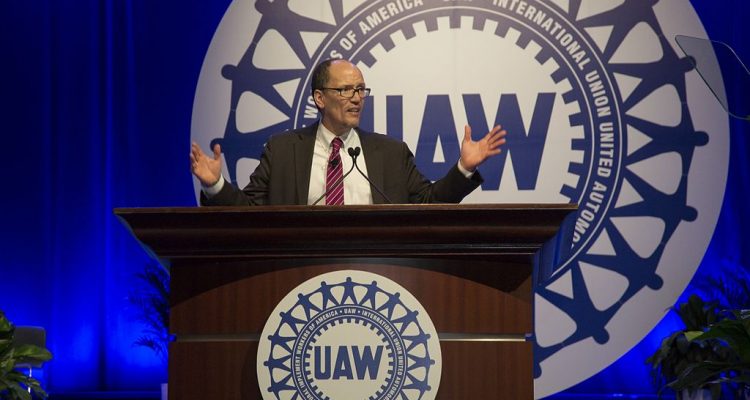The UAW is a Model of How a Union Can Be Impactful and Influential Even When Unions in General Are Struggling to Survive
Introduction
The erosion of collective bargaining rights and union power has adversely affected almost every labor union across the spectrum. Across America today, unions and employers have developed increasingly combative relationships and employers are aggressively undermining unionization efforts, much like the controversial anti-union video campaign Target ran in 2014[i]. So how are the auto industry and the United Automobile Workers (UAW) union any different? I firmly believe that while labor today is largely suffering from an increasingly hostile movement against unions, the UAW has taken steps during and beyond the 2009 Auto Bailout that has ensured its continued relevance and influence in the auto industry.
The Controversy Behind Labor Unions
Unions have had a controversial history and they have existed in almost every conventional industry. The purpose of a labor union is to give its members the power to negotiate better working conditions and additional benefits through collective bargaining as well as to act as an intermediary between workers (labor force) and managers of businesses[ii]. Some see unions as a facilitator of labor rights. Union benefits include the possibility of better wages, improved access to retirement benefits, better job security and protection from discrimination and inequality. However, unions can also become prohibitively expensive and can sometimes act as cartels in strong arming businesses[iii].
Despite the controversy shrouding the effectiveness of unions, there’s no denying that labor unions have been an integral force in helping build the middle class and in establishing workers’ rights. Ever since the founding of the National Labor Union (NLU) in 1866, labor unions have been driving the labor movement forward, leading efforts to stop child labor, provide health benefits and aid to injured and retired workers. These efforts have inspired a conception of a fair and just society derived from the Ricardian Labor Theory of Value[iv] as well as early American ideals such as “social equality, honest labor and virtuous citizenship”[v].
Stagnation and Decline of Labor Unions
But over the past decade, unions have been suffering. According to data from the U.S. Bureau of Labor Statistics, in 1983, there were 17.7 million[vi] union workers compared to 16.3 million members in 2000[vii] and the 14.8 million members in 2015[viii]. Figure 1 (below) shows the magnitude of the declining membership between the formative years between 2000 to 2015. This decline is rather alarming, as it signifies a somewhat stagnant, and even declining, growth of unions in general. This could be due to a myriad of reasons, but two of the main antagonists are anti-union laws and Supreme Court rulings against some workers’ rights, which in extension, is a blow to union efforts.
This has all been crippling to labor unions both locally and nationally. Wisconsin Governor Scott Walker’s efforts to pass anti-union laws in his state in 2011 have led directly to “unions representing teachers, professors, trash collectors and other government employees struggling to stem plummeting membership rolls and retain relevance in the state where they got their start”[ix]. Walker’s views, like many others in contemporary society, are based on a strong belief that union power should shrink and workers should be judged solely based on their merits and credentials. For many union members, this meant losing valuable benefits, or even their jobs. Furthermore, Indiana Governor Mitch Daniel’s “Right to Work” law and Ohio Governor John Kasich’s attempt to repeal collective bargaining rights for public employees in his state also set out to undermine union efforts. Despite the determination of some local unions to lower membership dues and trumpet union principles to entice young professionals to rejoin, most people no longer see the value of being part of a liberal movement that has faced so much backlash from the most powerful conservative institutions in the United States.
On a national level, the highly contentious Harris v. Quinn case, decided in the Supreme Court in 2014, revealed a great deal. First, the conservative majority on the Supreme Court during the ruling clearly had a distaste for state laws requiring public-sector workers to pay dues. Second, the justices voted 5-4 to issue a very narrow ruling that home healthcare workers in Illinois were not compelled to financially support a union they didn’t wish to join[x]. Many expected the Supreme Court to strike down partial dues (agency fees) as unconstitutional, so the ruling was a relief to unions, but it was still a blow to overall union efforts and collective bargaining rights for health workers.
Both these local and national efforts to curb the influence of unions have adversely affected the effectiveness, impact and scope of union work over the years. And for most labor unions, these impairments and obstacles do not appear to be letting up anytime soon. However, the UAW union has been an outlier to this general trend. As shown in figure 2 (below), data from the Bureau of Labor Statistics at the U.S. Department of Labor shows that even though UAW union membership has dropped sharply from its peak of 1.5 million in 1979, there has been a steady increase in membership yearly ever since its role in the successful Auto Bailout orchestrated by the Obama Administration (and in part by the Bush Administration). Currently, the UAW has about 410,000 members, up from a low of 355,000 in 2009 post-recession. I want to argue in this paper that the UAW has been a refreshing example of how a labor union can continue to be relevant and influential while labor struggles to stay prominent around the country. In addition, I would like to explore the role that both President Obama and the Auto Bailout had on the UAW and how both of these factors essentially created a series of events that allowed the UAW to not only survive, but also thrive in the current harsh ecosystem of anti-union sentiment.
Figure 1. Total Union Membership

Figure 2. UAW Membership

Data for Figure 1 and Figure 2 taken from the Bureau of Labor Statistics at the U.S. Department of Labor
The Start of the UAW
The UAW was chartered in Detroit, Michigan, by The American Federation of Labor over 80 years ago in 1935. Through orchestrated strikes and negotiations, the UAW gained significant leverage in major industries. For a critical period in American manufacturing history, no union was more powerful than the UAW, which, at its peak in the 1970s, represented millions of workers in a wide variety of industries ranging from insurance to aerospace and defense. Half a century ago, the UAW was so pervasive in everyday life that many workers with manufacturing jobs were likely to be a member of the union. When we think of the mid-20th century, we think of the American post-WWII economic expansion and the “Golden Age of Capitalism”. We remember this time as the epitome of patriotic consumerism and “American Made” products. We also associate this period with suburban development, urban sprawl and high productivity in key industries such as automotive manufacturing and agriculture.
The UAW’s Influence and Relationship with US Automakers
The UAW did not take long after its founding to make its mark on the American automotive industry. In 1936, the UAW helped orchestrate strikes at GM plants in Flint, Michigan, targeting many important GM plants in order to incentivize GM to negotiate new worker’s right contracts. This was the first of many successful strikes and protests managed, in part, by the efforts of the UAW. Over the years, the UAW has won union recognition and contract negotiations through strikes at GM, Chrysler and Ford. The results of these negotiations include:
- The first paid holidays for GM workers in 1947
- The first employer-paid and jointly administered pension program at Ford in 1949
- Fully paid hospitalization, surgical and medical insurance for retirees in 1964
- Landmark givebacks on wages and health benefits in contract talks with Detroit’s “Big Three” in 2007
To understand just how powerful the UAW was in the past, we should look at their achievements from a social perspective. The UAW has had a hand in many major sociopolitical events, from supplying the money and busses for the 1963 March on Washington to providing financial help for Cesar Chavez’s farmworker union and grape boycott. They’ve also given substantial funding to Earth Day organizers, the National Organization for Women and Students for a Democratic Society.
The Great Recession’s Effect on the UAW
Then, in 2008, the entire country plunged into a deep recession, the likes of which we have not seen since the 1930s. This recession brought with it the near-collapse of our deregulated capitalistic economy, and the subsequent federal bailout in 2009 to help keep GM and Chrysler from going completely bankrupt.
The share prices of the Detroit’s Big Three automakers had been falling precipitously before the need for a bailout arose. Faltering sales, increased foreign competition and quality issues all led to the Big Three suffering huge losses and burning through significant amounts of cash. In fact, by the end of the fiscal year 2008, GM was $30.9 billion[xi] in the red. This meant that these behemoth companies needed to cut costs, and massive layoffs were a very efficient way of doing so. Thus, the UAW, in order to help these automakers keep their heads above water, had to make significant concessions prior to and during the bailout. Some of these concessions included the loss of eye care and dental coverage for workers as well as significant wage reductions. The UAW also allowed the auto companies to pay significantly lower wages for new hires who made about half the amount that union workers made. The UAW likewise had to transition to a profit sharing business model, which meant that the UAW members made no profit during the tough years in Detroit when the automakers were going under. Cost of living adjustments were similarly suspended and overtime pay was adjusted, while pensions were eliminated for new hires. And last, but not least, the terms of the government bailout banned strikes at GM and Chrysler, essentially allowing these auto companies the power to dictate labor practices and working conditions. It was a tumultuous time for unions and for the UAW indeed.
GM and the UAW
When President Obama turned the keys of the bailout over to Steven Rattner and “Team Auto”, his plan was to save General Motors by segregating and then spinning out valuable assets while using taxpayer money to keep the company afloat while “Team Auto” executed the financial engineering and private equity deal required to make GM (and Chrysler) leaner and more sustainable in the future.
GM was often bashed in public for poor management and lackluster product offerings and many people blamed GM’s problems on complacency as a “too big to fail” American company. But there’s another side to the story. Amidst all of the noise of threats of bankruptcy and economic depression, the UAW actually struck a few deals with GM that positioned the automaker not only to survive, but also to pull off an extraordinary turnaround. In addition to the concessions mentioned earlier, one of the critical concessions that the UAW made in light of GM’s financial troubles was a historic agreement that “cut in half hourly pay for new employees and significantly scaled back the traditional retiree benefit packages that had been crippling the company, while also funding over $100 billion in unfunded retiree obligations”[xii].
The Results
When President Obama stepped in to take over the bailout of GM in March 2009, he forced out GM CEO Rick Wagoner and facilitated a merger between Chrysler and Fiat. In addition to this, Obama routed $77 billion in TARP fund loans to both GM and Chrysler to help. Despite these generous loans and strategic moves, both GM and Chrysler eventually filed for Chapter 11 bankruptcy, which created the “New Chrysler” and “New GM”, of which the federal government would have a significant stake. The bulk of the assets of both “old” companies were sold and the extra funds were used to settle outstanding obligations to creditors.
By the middle of 2009, both companies had already begun the recovery process. GM was now leaner and Chrysler was thriving under its alliance with Fiat. The UAW was given a sizable stake in both companies as a result of the Obama Administration’s support of union efforts and their belief in furthering worker rights and labor law as a method of reforming the giant automakers. Initially, the UAW received a 17% stake in GM and a 55% stake in Chrysler. According to Politifact, now the “[United Auto Workers] trust owns 39% of General Motors and 55% of Chrysler”. When GM went public at the end of 2010, they raised almost $20 billion, which, at the time, was the largest IPO in American history. The stock sale resulted in the government reducing their share of GM by about half and the UAW doubling its shares in the auto giant. This resulted in a huge potential payday for the UAW as well as a board seat on the restructured GM board to ensure a say in future business decisions.
Recently, the UAW has continued to build up its membership and exert its influence in the auto industry by negotiating new contracts with the Big Three. In a milestone negotiation, the UAW has reached a new four-year labor contract with General Motors, which comes on the tail of a new agreement between the UAW and Fiat-Chrysler as well. This is all happening while GM just posted a $1.4 billion profit in the third quarter of 2015 with a net revenue for the period at an impressive $38 billion. GM’s adjusted earnings per share increased 96% from the third quarter of 2014 and GM North America also set records for EBIT adjusted and EBIT-adjusted margin values in 2015. Under CEO Mary Barra’s leadership, GM is driving earnings growth and providing significant shareholder value. Much of GM’s ability to grow was a direct result of the UAW’s unprecedented concessions in the post-recession labor agreement in 2011 and its role in helping lower GM’s costs and commitments during the Auto Bailout.
As a result of these new contracts with the Big Three, the UAW membership has been climbing steadily again (figure 2), with more members projected to join from the resurgent automotive industry and other fields such as gaming and higher education. Last year was the fifth straight year of membership gain for the UAW, and this momentum is only going to build as the union continues to pick up organizing victories. Among the Detroit Big Three, the UAW currently represents almost 140,000 workers, and have picked up new members at casinos in Cleveland and graduate employees at the University of Connecticut. The UAW also won the right to represent more than half of Volkswagen’s hourly workers who have joined UAW Local 42. They are not the exclusive collective bargaining agent for these members, however, and so that is a slight drawback.
Challenges the UAW Faces Moving Forward
Despite their substantial efforts to continue representing workers in the auto industry and beyond, the UAW faces significant challenges to both its welfare and long-term sustainability. First of all, the low membership and high member churn rate will make it hard for the UAW to influence labor law and workers’ rights on the same scale that it could at its peak. The challenge of improving membership is further complicated by automation, technology and artificial intelligence, all of which are now able to replace human labor.
In addition, another challenge to the sustainability of the UAW is outsourcing. Major national auto manufacturing companies are struggling to post profits and are still reeling from the aftershocks of the Auto Bailout. As a result, big auto manufacturers are looking to cut costs and are choosing to purchase more car components abroad rather than from local sources. Outsourcing parts encourages foreign competition, such as Japanese auto companies, to expand their operations by building new plants in the United States. Labor law covers workers at American companies, so foreign competitors can effectively resist union organization and influence while simultaneously reaping the benefits of lower costs with U.S. based operations and facilities.
Furthermore, unions face the challenge of foreign competition. Many UAW members cannot compete with workers in China, Mexico (and other countries with cheap labor) with regards to wages and benefits. These foreign workers can produce comparable products at a fraction of the wage American workers make and so over time, these industries that UAW members work in could increasingly rely on this more affordable workforce after globalization opened up American markets and paved the way
Finally, as we saw with Governor Walker’s crusade against union power in Wisconsin, laws dismantling financial and organizing structure of unions also pose a threat to the labor movement. With skyrocketing costs and less structure, unions are losing their influence and private-sector workers are now increasingly choosing to opt out of paying union dues, further crippling the delicate financial state of unions. The result of Walker’s campaign against labor unions has resulted in
“the state branch of the National Education Association, once 100,000 strong, [seeing] its membership drop by a third. The American Federation of Teachers, which organized in the college system, saw a 50 percent decline. The 70,000-person membership in the state employee’s union has [also] fallen by 70 percent”[xiii].
The results of financial strain can be seen on the UAW’s balance sheet. Data from the UAW ledger indicates that in 2014, their total assets were $978.1 million, which was $11 million less than the $989.9 million in total assets the UAW held in 2013. Also, the UAW Secretary-Treasurer Gary Casteel also revealed that the UAW has lost money for each of the past 5 years, including $10 million lost in 2014. However, to put this into perspective, the UAW posted a loss of $42 million in 2010, so it’s clear the UAW is on the right path to recovery and even future prosperity.
Essentially what all of this shows is that many large unions are vulnerable, and the UAW is no exception to similar vulnerabilities. The UAW has to continue to work with political allies, most likely Democrats and other liberals, who will continue to help the UAW fight to improve the working conditions and benefits of its members.
Final Thoughts
The Big Three, in conjunction with the UAW, are committed to rebuilding the American manufacturing base, and therefore propping up the American middle class that’s so essential to the well-being of the American economy. By saving Detroit, America chose to save millions of jobs and to preserve the sanctity of the American dream. Labor and government working together to save the auto industry has created a new precedent that has instituted fundamental changes to both the global economy and the national labor movement. Democracy cannot survive without a strong middle class, and this middle class is the core of what the UAW represents. By consistently trying to improve working conditions and terms for its members through collective bargaining efforts, the UAW has proven that it’s here to stay and will not fade away like many other unions and labor movements have over the past decade. This also proves that in the face of intense scrutiny and general distrust of unions, the UAW can successfully collaborate with unionized auto companies to innovatively and constructively solve problems and create fair working environments to continue to stimulate the growth and prosperity of the American middle class and workforce.
—
Jonathan is currently a second-year MBA candidate at the Cornell University – Johnson Graduate School of Management. He is the editor-in-chief of the Cornell Business Journal and is also a regular policy contributor to the Cornell Policy Review and other publications. Jonathan holds a B.A. in history from Rice University.
Like what you read? Share, like, and comment. Connect with me on LinkedIn or reach out via email: jlh494@cornell.edu. All opinions expressed are my own and do not reflect the opinions of any of my affiliated educational institutions, organizations or companies.
Works Cited
Bigman, Dan. “How General Motors Was Really Saved: The Untold True Story Of The Most Important Bankruptcy In U.S. History.” Forbes. November 18, 2013. Accessed October 19, 2016. http://www.forbes.com/sites/danbigman/2013/10/30/how-general-motors-was-really-saved-the-untold-true-story-of-the-most-important-bankruptcy-in-u-s-history/#740456a25acc.
Estlund, Cynthia, and William E. Forbath. “The War on Workers.” The New York Times. July 2, 2014. Accessed October 19, 2016. http://www.nytimes.com/2014/07/03/opinion/the-supreme-court-ruling-on-harris-v-quinn-is-a-blow-for-unions.html.
Supreme Court of the United States. “Harris vs. Quinn.” June 30, 2014. Accessed October 19, 2016. https://www.supremecourt.gov/opinions/13pdf/11-681_j426.pdf.
History.com Staff. “Labor Movement.” History.com. 2009. Accessed October 19, 2016. http://www.history.com/topics/labor.
Investopedia. “Labor Theory Of Value.” Investopedia. January 24, 2010. Accessed October 19, 2016. http://www.investopedia.com/terms/l/labor-theory-of-value.asp.
Lombardo, Crystal R. “10 Essential Pros and Cons of Unions | NLCATP.org.” NLCATP.org. January 27, 2015. Accessed October 19, 2016. http://nlcatp.org/10-essential-pros-and-cons-of-unions/.
Samuels, Robert. “Walker’s Anti-union Law Has Labor Reeling in Wisconsin.” Washington Post. February 22, 2015. Accessed October 19, 2016. https://www.washingtonpost.com/politics/in-wisconsin-walkers-anti-union-law-has-crippled-labor-movement/2015/02/22/1eb3ef82-b6f1-11e4-aa05-1ce812b3fdd2_story.html.
Semuels, Alana. “What One Union Learned From the Recession.” The Atlantic. September 7, 2015. Accessed October 19, 2016. http://www.theatlantic.com/business/archive/2015/09/what-the-unions-learned/403963/.
“Union Members in 2000.” U.S. Bureau of Labor Statistics. January 18, 2001. Accessed October 19, 2016. http://www.bls.gov/news.release/history/union2_01182001.txt.
“Union Members Summary – 2015.” U.S. Bureau of Labor Statistics. January 28, 2016. Accessed October 19, 2016. http://www.bls.gov/news.release/union2.nr0.htm.
Wang, Ucilia. “Why Target’s Anti-union Video Is No Joke.” The Guardian. March 31, 2014. Accessed October 19, 2016. https://www.theguardian.com/sustainable-business/target-anti-union-video-cheesy-but-effective.
Utility Workers Union of America, AFL-CIO. “What Are the Benefits of Being a Union Worker?” UWUA Utility Workers Union of America AFLCIO. January 13, 2012. Accessed October 19, 2016. http://uwua.net/organizing-campaigns/lee-county-what-are-the-benefits-of-being-a-union-worker.html.
[i] Wang
[ii] Utility Workers Union of America
[iii] Lombardo
[iv] Investopedia
[v] History.com Staff
[vi] Union Members Summary – 2015
[vii] Union Members in 2000
[viii] Union Members Summary – 2015
[ix] Samuels
[x] Supreme Court of the United States
[xi] Bigman
[xii] Ibid.
[xiii] Samuels
Featured image courtesy of Wikimedia Commons.






